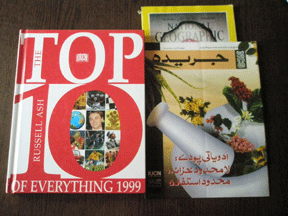I went to visit the doctor two days ago. At the clinic, I was given a waiting number. Now this clinic is a bit of a run-down operation, but I trust the doctor for his accurate diagnostic skills and the ability to treat a patient with more kindness and less medicine. He also chooses to run a clinical practice in a less-privileged area. When asked why, he once said, “This is where I am needed.”
So, I sat with the square little cardboard paper card that bore my patient-calling number. I noticed, during the ample idle time, this card. It had been fashioned out of medicinal packaging ‘repurposed’, so to speak with the number ’23’ written with a blue ballpoint pen. Highly unimaginative, this piece announced, “You are sick!” in subtle ways.
My mind wandered at this sight, and I thought: “Why, in all my years of visiting this clinic run by a rather selfless man who could have earned millions healing people in a ‘better’ facility, have I not thought of contributing anything to this clinic?”
I looked around, and saw many flu-ridden children amongst the patients. I noticed that the bookrack had books that were wilting due to overuse. There were some nice posters on the wall masked advertisements of pharmaceutical companies. All in all, the clinic could use a paint job, some fresh art on the walls, and new books and magazines in the racks. It could use something to engage the children in waiting, something better than the ancient TV overhead. It could use some engagement for the men and women, seated in separate quarters, who sometimes spend more than an hour waiting for their turn. Precious productive time was idled away at this clinic.
Finally, the clinic could certainly use more imaginative and perhaps enduring – not to mention hygienic cards or chips with waiting numbers.
I imagined:
What if I go home and make artistic cards for them with a beautiful, heartening picture and perhaps some uplifting words? What if I bring some art for the walls? What if I bring some of my magazines and books?
Then I ploughed a bit deeper with my question:
Art classes. There are so many art classes in so many schools in this city. And they create ‘stuff’ only to relegate most of it to the dark, fungal cupboards of the class. Some schools do not let the children take their projects home – especially if those are examination assignments – and most of the productions simply end up as piles of junk.
In school, we often made art no one eventually cared for. Most children created with half a heart because they could not ‘see’ the end purpose of this enterprise. “What’s the use of all this?” is a common complaint in classrooms and campuses.
Yet here, in this city, there are clinics and homes and bus stands that could use more art, more beauty.
Why is there a gap between the two?
In this gap, one is forever needy, and the other is forever producing unappreciated, unused junk. There is a break in what ought to be a cycle of giving and receiving.
I recalled that some years ago, I became familiar with the idea of ‘service learning’ – that is, learning in academic settings through real service projects. For instance, a student of architecture would actually implement a working solution for a (needy) community in order to obtain a pass in the subject. Real service projects are carried out under this paradigm. What an idea! Academia does not waste years of knowledge that children acquire, asking them to wait till they grow up to become functionally useful (as traditional education does). One serves and learns as one goes – and (almost) everything that is produced is utilized.
Service. That was the key theme that I was digging for. Business, academia, communities, individuals – if they act to serve, not only will there be many needs fulfilled and bonds created but so, too, will there be less physical junk in the world.
Service. Service keeps our relationships cyclic, in action – service keeps us connected as people and as organized groups.
Service. This is what makes a human of whichever station or status useful and therefore connected to other humans.
Service. This is going to make life (more) sustainable – for sustainability is nothing more than ‘elements of life in an effortless perpetual cycle’, a definition I proposed in my article ‘Why We’re Failing to Sustain – and How Can We Succeed, Right Now’ published in tbl in July 2009.
It all made sense to me. I looked down at the little crumbling cardboard slip in my hand. It was made out of the cover of a package which must have contained a cough syrup bottle within. The negligible little card had educated me about the scheme of things. It also showed me the way to begin.
On my next trip to the clinic, I am taking along with me some posters and books and magazines that I have tried to give away in the past. Mysteriously, they have refused to go away, and ended up with me again. They know better; that there is a just-right place in the world for them; they refuse to be sold away to a paper junk dealer (one who thought they are ‘too good’ to be taken away) or to be taken up by visiting friends (“Too heavy! I shall take them next time!”). I shall donate those to the clinic. My junk will become treasure through service.







If there are many people in the world who can see that their less of use items may be like treasure and very usefull items for some others and take little pain(in fact, pleasure) to reach out to needy, under previledged or sick travellers/patiants, wold will become a better place( a sustainable planet).
Very impressive, please keep working. You are an inspiration for working towards the social good.